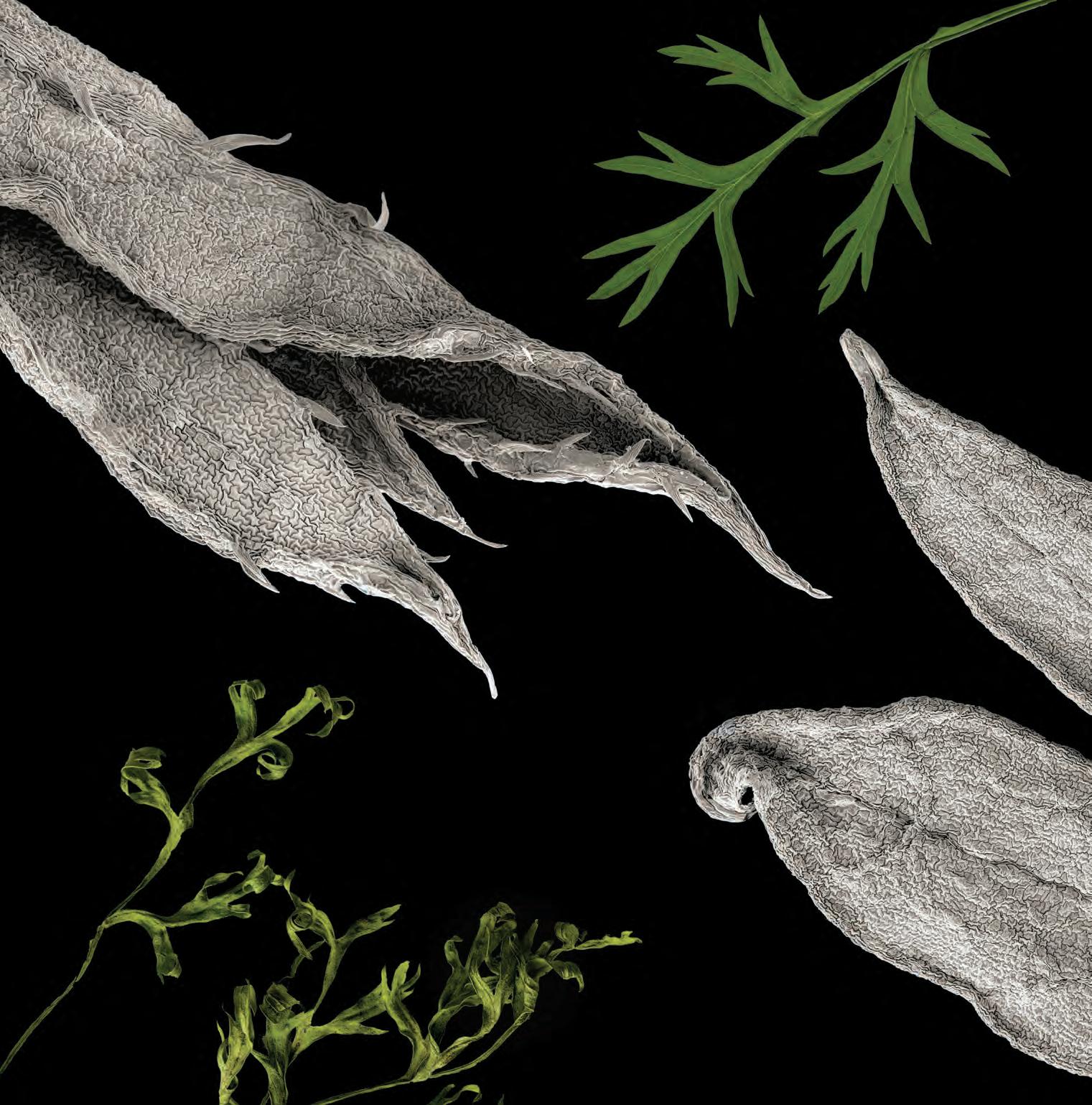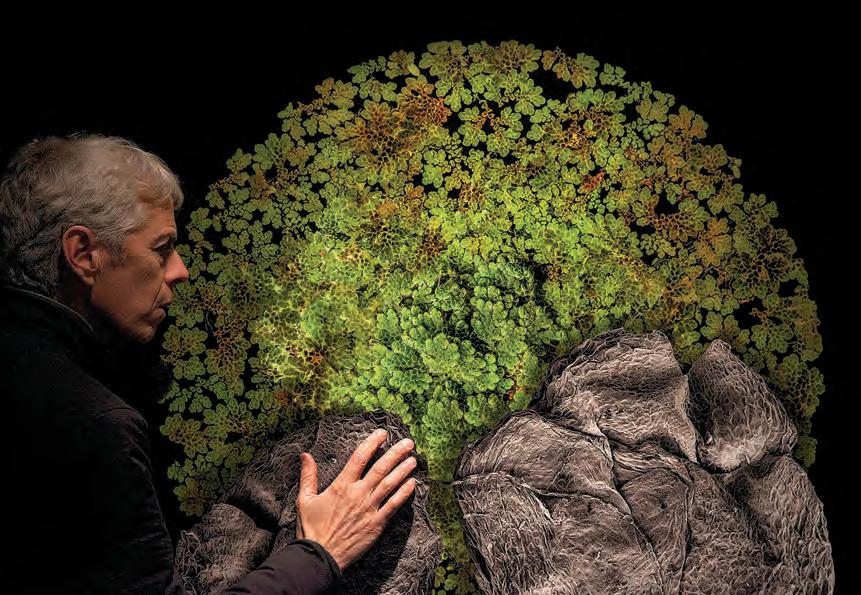
ANATOMY OF A MONTAGE

MONOCHROME

EMBRYONIC RICE

RICE PANICLE
RICE AWN (TIP)
RICE PANICLE
RICE ANTHERS AND POLLEN 340×
RICE AWN DETAIL 340×
RICE PANICLE
RICE GRAINS


AZOLLA
A FLOATING FERN THAT ONCE REMOVED HALF OF ALL ATMOSPHERIC CARBON
I had never heard of Azolla until I visited Kirchoff Farm, on the San Juan Islands. Farm owner Dan reached down into a shallow trough in his field and handed me a moss-like clump. The humble plant reminded me of duckweed and other common algae. I brought it home, did a brief internet search, and was stunned by what I learned.
In 2004, a scientific expedition to the Arctic took core samples of the seabed and discovered 49 ft (15 m) of compressed, fossilized Azolla. It appears that there was a massive freshwater resource in this region, where Azolla flourished between 48 and 49 million years ago in “the Arctic Azolla Event.” It is credited with removing half of the carbon dioxide from the atmosphere at the time during its flourish, resulting in cooler global temperatures, particularly at the poles.
This fast-growing, high-protein plant is used for livestock feed and fertilizer. Ecuadorian, Indian, Thai, Indonesian, and other farmers value this “floating fern” as a rich source of nitrogen. The fern’s symbiotic relationship with the cyanobacteria Nostoc azollae enable it to replace petroleum fertilizers that support crop growth. Azolla that is grown in conjunction with rice is especially effective. In Asia, a system that integrates fish and Azolla into rice-duck farming shows promise: Azolla provides the nitrogen needed for the rice; ducks eat the Azolla (and invasive snails), and their manure naturally fertilizes the soil.
Azolla can double in size every few days. One unique strategy is to grow azolla using industrial waste heat and CO2, creating unique, closed-loop management of these industrial pollutants. Azolla produces lipids, making it a potential source of biofuels. Because it is a water-based plant, it doesn’t compete with other crops for scarce arable land. It offers an inexpensive source of easily digested animal feed, giving small farmers an alternative to expensive grain.
In some regions, Azolla is considered a nuisance – the UK banned its sale in 2014, listing it as an invasive species. It can choke out other aquatic life and plants and degrade water quality. Still, this plant’s impacts and potential extend far beyond its diminutive size, and in the right setting it plays a crucial ecological role.
MACRO: Azolla, floating fern, Azolla filiculoides
MICRO: Azolla floating fern; leaf detail: 130×
BLUEBERRY
CROP WASTE PRODUCT S AND A CIRCULAR ECONOMY
Viewing foods at the microscopic level reveals mysteries worthy of lifelong questions, research, and just plain wonder. My SEM work revealed the surprisingly patterned surface of a tiny blueberry seed. This image is inspired by the 1968 Earthrise photo taken by William Anders whose iconic photograph helped launch the environmental movement. Unlike every other image in this book, this one came together in a flash. As I worked on the blueberry composition, removed the studio background from behind the berry, and added a black background, the idea of berry-as-Earth leapt out.
In the 1850s, Henry David Thoreau documented the average flowering time for highbush blueberries near his home in Walden Pond, Massachusetts, at around May 16. Just 60 years later, Boston University biologist Richard Primack found that this had accelerated to April 23, with April 1, 2012, being the earliest date recorded. Blueberries worldwide are impacted by these seasonal shifts, which bring extreme weather, introduce new diseases and pests, and wipe out pollinators.
Random freezes on top of early budding can destroy harvests. And just four hours of heat above 95°F (35°C) can fatally damage blueberry pollen. As with many crops in the northern hemisphere, the range in which blueberries thrive is moving north. Quebec is now competing with Maine as a source of wild blueberries (“wild” being a euphemism, since native forests of jack pine have been clear-cut to make way for this popular and profitable food).
Blueberry crop waste products have found use as biochar, compost, and nutraceuticals. Biorefineries create biofuels with blueberry waste, (pomace). These tools fit a circular economy model, a recent name for an oftneglected practice of maximizing a product’s usefulness while turning waste into assets.
Savvy consumers pay careful attention to the geographical origins of their food. This is a core value of the locavore movement. Many would be surprised to learn that it is the method of transportation, more than the distance traveled, that greatly affects a food’s carbon footprint (or foodprint, as the nonprofit group by that name suggests). Once blueberries are harvested, the carbon footprints of their transportation methods may differ greatly. ClimateSmart Food author David Reay finds that a box of blueberries grown in the UK, and one transported there via ship have similar carbon footprint, while a similar box arriving by air has ten times that measure. This is a good argument for pick-your-own farms.
MACRO: Blueberry, Vaccinium corymbosum
MICRO: Blueberry; seed surface texture: 300×




RESTORING GREAT UNDERSEA FORESTS
One of our family’s favorite activities is snorkeling in the local Salish Sea. While visiting a particular wall over the years, we started to notice an increasing proliferation of green urchins. There were sections of wall that were scoured clear, and all that remained were densely packed urchins. On one trip, I came upon the stipe (stalk) of bull kelp being devoured by several of these predators, and was both grateful for the evidence, while saddened to catch them in the act of destruction.
In 2015, a warming ocean-induced wasting disease began to devastate large populations of sea stars along the northeastern Pacific coast. Sunflower stars, apex predators of the coast which are capable of reaching three feet (90cm) in diameter, have nearly been wiped out. Sea stars prey on the urchins, and the stars’ decimation has led to an explosion in the urchin population. One of urchins’ favorite foods is kelp, whose massive forests along coastlines provide rich carbon sinks (and thus, reduced ocean acidity), while being a biodiversity haven, a protective habitat for fish and crabs, and a source of sustainable food for humans. This image dramatizes the voracious appetite of urchins as they ravage bull kelp in the Salish Sea. Kelp forests from Tasmania to Norway, as well as along the US’s Pacific coast, have also witnessed tremendous losses.
Urchins are considered a delicacy in Japan. Kelp forests and urchins were once prolific in coastal Maine; Maine anglers mined this “green gold” in the 1980s and 1990s, flying a yearly peak of 40 million pounds (18 million kg) of green urchins halfway around the world to feed the demand. (It should be noted that food transported by airlines is one of the most carbon-intensive sources of nutrition.)
SeaForester raises kelp on land, using small stones as kelp anchors. Within months, these “kelp stones” are sown like seeds in the ocean, a method that is showing great promise. Along the Northern California coast, other efforts are underway to restore kelp forests whose bull kelp populations crashed by 96% between 2014 and 2020. One diver developed large vacuums which could remove 200,000 purple urchins a day from urchin barrens – zones scraped clean of nearly all life. Urchins go dormant in these barrens when their preferred kelp is gone. They can live for decades, becoming nearly empty (and worthless to both predators and divers as a result). The firm Urchinomics employs divers to collect dormant urchins, clearing cliffs and rocks so that the kelp can return. The weakened urchins, now on land, are farmed back to full health, and marketed as a commercial food.
Efforts such as these put a dent in the global urchin population, which is likely to be billions strong. Warming seas also hamper recovery efforts; kelp dies when water temperatures rise to 64°F to 69°F (18°C or 20°C).
MACRO: Bull kelp, Nereocystis luetkeana; head and blades, showing urchin chew marks; green urchin, Strongylocentrotus droebachiensis
MICRO: Green urchin; tube foot disk: 270×


LETTUCE 2.0
MICROGREENS AND HYPERLOCAL, NUTRIENT-DENSE VEGETABLES
Microgreens might be the ultimate in healthy, local (kitchen counter) produce, with a minor carbon footprint. These tiny vegetables (though not the same as sprouts) are packed with more key antioxidants and nutrients – such as vitamin E, K and C – than the mature versions of the same plant. For example, red cabbage microgreens have 40 times the vitamin E compared to mature red cabbage. The same nutrition value can be received from broccoli microgreens as opposed to mature broccoli, all while using 200 times less water.
This image features radish, mustard, sunflower, fennel, sorrel, Japanese onion, nasturtium, arugula, and purple basil, in a mix conceived as a miniature food forest, with the canopy complexity, textures, and beauty of tropical rainforests.
– Opposite: design by Emily Deason at BabyPower Microgreens

Nasturtium microgreens


PLANKTON
TINY PLANTS THAT PRODUCE HALF THE WORLD’S OXYGEN
Long ago, I spent a summer as a naturalist along Washington State’s Olympic Peninsula. One morning, I stood by a river feeding the Pacific, and all of the dots connected: sandy silicon from eroded inland mountains washed to the sea, diatoms used that silicon for their structures and in turn, produced half of the globe’s oxygen. Some epic transformations happen silently, and these plants – just a fraction of a pinhead’s width – have such power. This image celebrates diatoms, the elegant host algae that they were attached to, and the ecological services they provide.
When we think about seafood, we rarely consider the one-celled diatoms that anchor the food chains of every ocean, priming the waters for tastier things. Those single-celled algae are under siege from climate chaos. While it is tough to describe its impacts over all of the oceans, especially as conditions vary worldwide, and affect plankton species differently, emerging patterns warrant attention.
Hotter deserts lead to more atmospheric dust. Iron in the dust is blown over oceans, fertilizing plankton blooms. When plankton die, they sink to the seabed, becoming a carbon sink for thousands of years. Ocean acidification caused by more absorbed CO2 leads to smaller plankton species with a limited ability to take up silicon. These plankton are less likely to sink and take their carbon into hiding.
Plankton stressed by intense summer UV radiation produce dimethyl sulfide which makes its way into the atmosphere and helps form clouds. Rising temperatures cause plankton species to migrate northward, disrupting food chains. Lower salmon populations increase the numbers of copepods, which decrease diatom populations. Coccolithophores, a marine phytoplankton that formed England’s White Cliffs of Dover, has spiked intermittently over millions of years during warm, high CO 2 periods, and is rapidly expanding in the North Atlantic. Toxic plankton near coastlines makes shellfish dangerous to eat, and their prevalence rises with warmer waters.
This rollercoaster view of shifting plankton fortunes is an example of the chaotic ecological changes underway. Individuals may recoil at the scale of the problem, but we can take a cue about real power from none other than these tiny organisms.
MACRO: Red algae, Cryptopluera ruprechtiana
MICRO: Diatoms, Isthmia enervis: 800×






